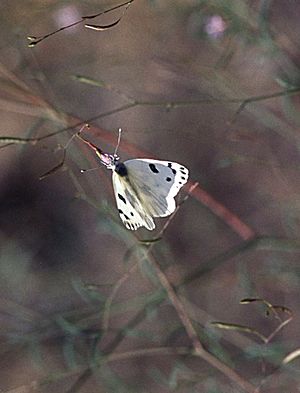Becker's white facts for kids
Quick facts for kids Becker's white |
|
|---|---|
 |
|
| Scientific classification | |
| Synonyms | |
|
The Becker's white (scientific name: Pontia beckerii) is a beautiful butterfly that lives in western North America. You might also hear it called the Great Basin white or sagebrush white. It belongs to the Pieridae family, which includes many white and yellow butterflies. This butterfly can be found all the way from Baja California, Mexico, up to southern British Columbia, Canada.
What Does It Look Like?
The Becker's white butterfly is mostly white. It has small black markings on its wings. Female butterflies usually have more dark markings than the males. This helps them stand out!
Its wingspan is about 33 to 48 millimeters. That's roughly the size of a large coin, like a quarter or a bit bigger.
You might find the Becker's white butterfly looks a bit like other "checkered white" butterflies. These include the Pontia sisymbrii, Pontia protodice, and Pontia occidentalis. They all share similar patterns.
Where Do They Live?
This butterfly loves open, dry areas. You can often spot it in places like deserts, grasslands, and areas with lots of sagebrush. Its wide range across western North America means it can adapt to different environments.
What Do They Eat?
Like many butterflies, the Becker's white has special "host plants" where it lays its eggs. These are the plants that the caterpillars will eat when they hatch. For the Becker's white, these plants include:
- Isomeris arborea (also known as bladderpod)
- Stanleya pinnata (desert plume)
- Brassica nigra (black mustard)
- Descurainia pinnata (tansy mustard)
- Sisymbrium altissimum (tumble mustard)
- Lepidium perfoliatum (clasping pepperweed)
- Schoenocrambe linifolia (flaxleaf plainsmustard)
- Thelypodium sagittatum (arrowleaf thelypodium)
- Thelypodium laciniatum (cutleaf thelypodium)
These plants provide the food and shelter that young Becker's white caterpillars need to grow.

